In 2022 there were just 3,194 billionaires across the globe. And unless a person is a beneficiary of substantial inherited wealth, it will take them considerable time to achieve billionaire status. While most self-made billionaires will have launched their first business at a relatively young age, it is rare for them to enter this exclusive billionaire status before their 40th birthday. Download the full Billionaire spotlight: Today’s billionaires by age group 2023 below.
The perception of the young billionaire
“While younger tech billionaires like Elon Musk, 51, and Mark Zuckerberg, 39, may dominate the wealth headlines, the majority of the world’s billionaires are over retirement age, according to a new study”
Robert Frank, CNBC
The median age of a billionaire is 67 years old. “Young” billionaires are defined as those 50 years old or younger. This group accounts for only 10% of the billionaire population.
CNBC’s Robert Frank interviewed Maya Imberg, Altrata’s head of though leadership and the lead author of the Billionaire Census 2023, to understand the age breakdown of today’s billionaires. “Many of the younger billionaires have made their wealth in tech, which has been a fast wealth-creation industry and gets a lot of media attention,” said Imberg. “But most wealth takes a long time to accumulate unless it’s inherited. It takes a vast majority of their business lives to create that amount of wealth.” CNBC.
But who makes up this younger group of billionaires? Who are they and what traits and characteristics should organizations engaging with this group know about? This article will examine this group’s gender split, top industries, wealth sources, asset allocations, top interests and more.
What is the gender breakdown of young billionaires
Female billionaires are more common in the young billionaire group. Just under 18% of young billionaires are women.
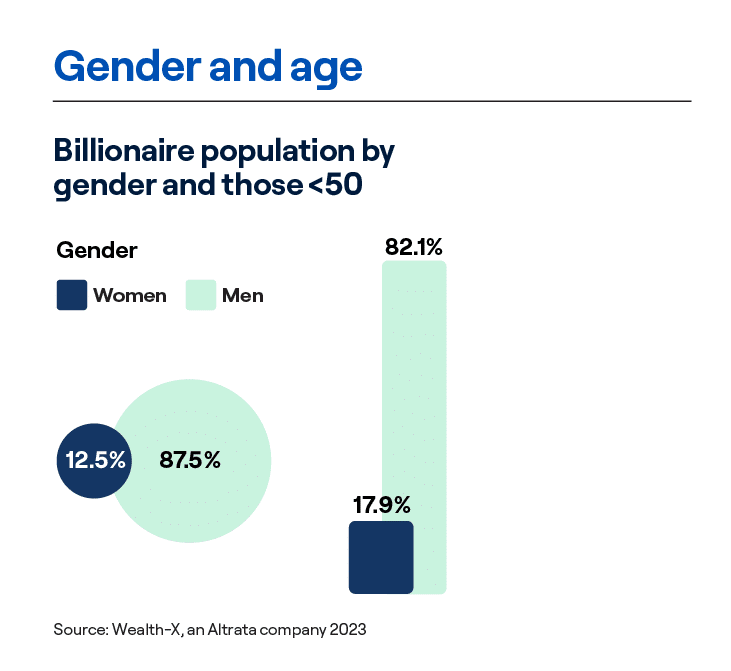
While there is a higher female representation among billionaires under 50, women still make up less than a fifth of all billionaires. As in other high wealth tiers, female billionaire representation is on a gradual upward trend.
Tech billionaires and other prominent industries
Banking and finance is the most common industry among billionaires. However, technology is the most prominent among young billionaires.
Within the young billionaire bracket, technology ranks a close second in importance, followed by business and consumer services and hospitality and entertainment. These are not the leading industries for billionaires aged 70+.
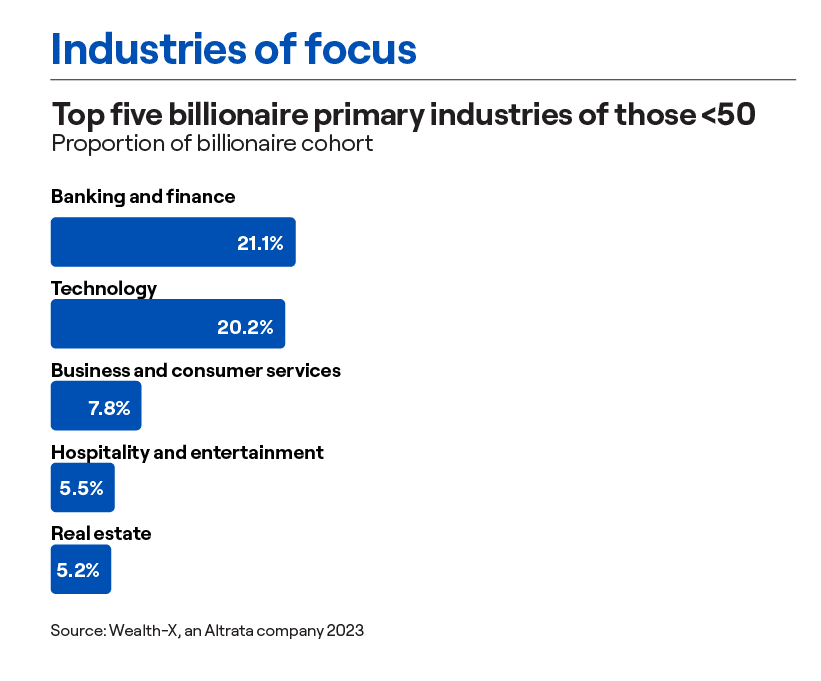
Technology and banking and finance are the top two primary industries for young billionaires. In a reflection of shifting economic and societal trends, technology is the primary industry for the largest share of under-50s in both Asia and North America, whereas, in Europe, the focus remains very much on banking and finance. Household names include China’s Chris Xu, founder of fast-fashion giant Shein, and Americans Mark Zuckerberg (co-founder and CEO of Meta) and Jack Dorsey (co-founder and former CEO of Twitter), though many of the more than 300 other young billionaires are not as well known to the public.

Source of wealth
Most billionaires are self-made. Young billionaires are twice as likely to have solely inherited their wealth compared with their older counterparts.
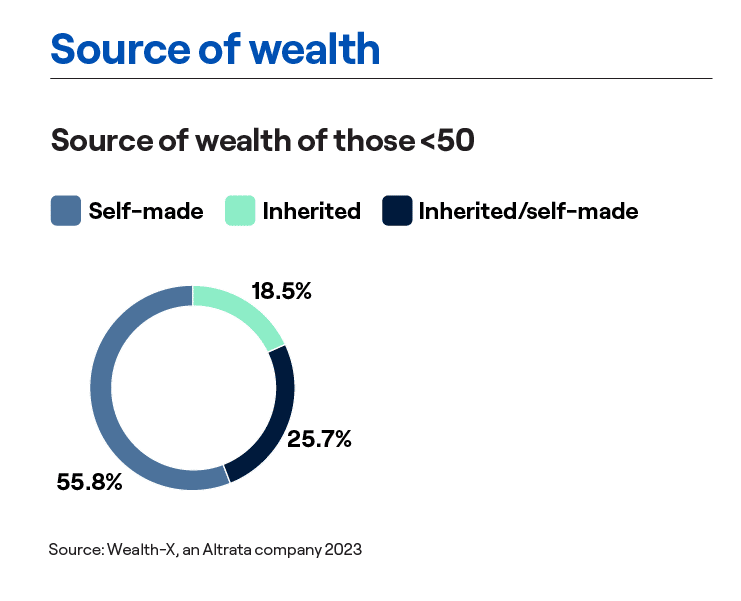
The standout trend is the larger prevalence of solely inherited wealth among the younger cohort of billionaires. This is partly attributable to the higher female representation in the under 50 population, as inheritance is a far more common source of wealth among women than men. Moreover, a growing number of inter-generation wealth transfers are also happening for the first time. Many of these fortunes, created over recent decades – particularly in newer wealth markets – are being passed down to younger family members.
Asset allocation
Public holdings comprise billionaires’ largest asset class, accounting for almost two-thirds among younger billionaires. The larger share of public holdings among the younger cohort (63% compared with 40% for those aged 50+) – mainly at the expense of privately owned assets/investments – reflects, to a large extent, the higher concentration of technology focused billionaires, whose asset allocation favors equity holdings more than other industries.
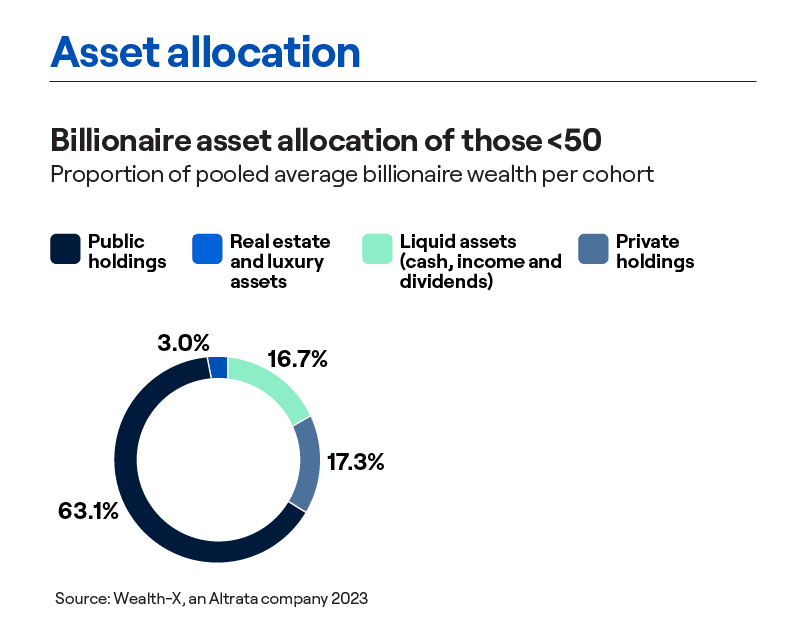
Interests, passions and hobbies
Across the billionaire population as a whole, sport and philanthropy stand out as the two favorite interests. Sports ranks highest among young billionaires, while technology ranks a close second, ahead of travel and music. Aviation, art and politics, in the top five among older billionaires, does not appear to be as much of interest to young billionaires. This likely reflects the stage of life young billionaires are in or differences in cultural preferences among the generations, or both.
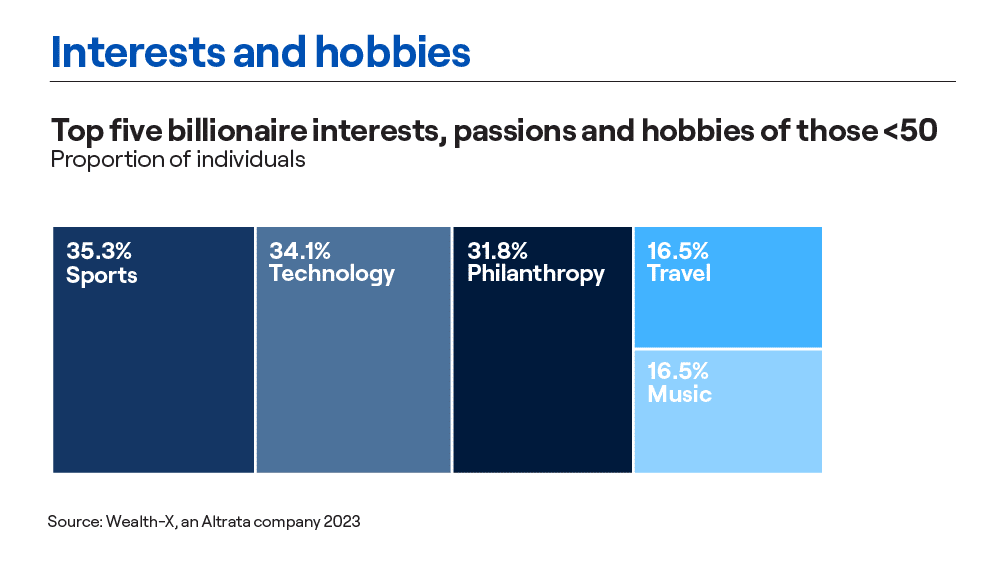
Philanthropic causes
Young billionaires’ philanthropic causes are largely in line with the rest of the billionaire population. Yet the proportion of young billionaires interested in each cause is lower than among the two older groups – this mostly reflects the fact that it is typically the older groups of billionaires that take a more active role in philanthropy given their stage of life they are in, and therefore this reflects in both a greater degree and wider range of philanthropic causes they are interested in.

Education is the most popular area for philanthropic activity for billionaires of all ages. For all three age groups, initiatives to improve educational facilities, teaching standards and learning opportunities are the most common area for charitable giving.
There is also broad interest in donating funds to social causes, healthcare and medical research, as well as arts and culture. In many countries, the increasing focus (and shifting policies) on climate-related issues will almost certainly mean conservation and environmental causes will attract an increasing share of donations in the years ahead.

Maeen Shaban is an expert in understanding the wealthy, specifically their populations, growth and trends which affect them across the globe. He is a lead author of Wealth-X’s main thought leadership reports, including the World Ultra High Net Worth Report, the Billionaire Census and the High Net Worth Handbook. Maeen continues to work with clients such as JP Morgan, Goldman Sachs, Rolls Royce, Loreal and Bill & Melinda Gates Foundation. He holds First Class Honours in Financial Engineering, has completed CFA Level II and conducted post graduate research on sovereign offshore investment strategies.